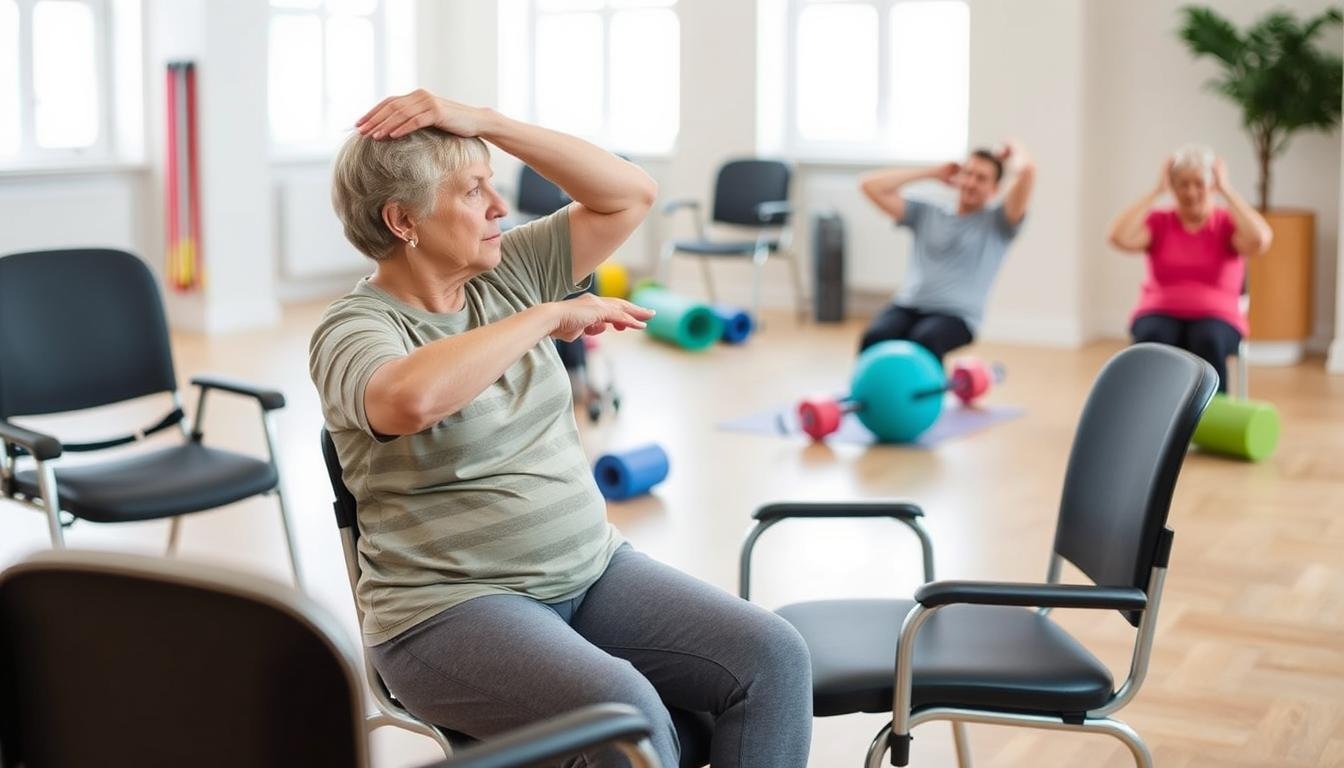For those with mobility challenges, adding simple exercise routines to daily life can change everything. Regular exercise boosts both physical and mental health.
Gentle exercises can make daily tasks easier by improving flexibility, balance, and strength. It’s key to pick activities that are fun and safe, considering your mobility limits.
Key Takeaways
- Simple exercises can greatly improve health for those with mobility challenges.
- Regular activity boosts flexibility, balance, and strength.
- Choosing enjoyable and safe exercises is crucial.
- Exercise plans should match individual mobility needs.
- Always talk to a healthcare professional before starting new exercises.
Understanding Mobility Challenges and Exercise Benefits
Many Australians face mobility issues that can be helped by the right exercise and support. These challenges can come from age, injury, or chronic conditions.
Common Mobility Limitations in Australia
In Australia, common mobility issues include arthritis, neurological conditions, and musculoskeletal disorders. These can make daily activities hard. Gentle movements and exercises can help ease these problems.
Physical and Mental Benefits of Regular Movement
Doing low impact workouts can boost heart health, strength, and flexibility. It also helps with mental health, lowering stress and anxiety. It makes us feel better and more independent.
Getting Started: Essential Equipment and Safety
To start exercising, think about your safety and what equipment you need. Using things like chairs or walkers can make gentle movements safer. Always talk to a healthcare professional before starting any new exercise, especially low impact workouts.
Live Healthier, Live Happier – Discover Our Wellness Support Services at 1300 755 052.
Easy Exercises for People with Mobility Challenges
Staying active is key for everyone, including those with mobility issues. There are simple exercises you can do every day. These help improve strength, flexibility, and overall health.
Chair-Based Strength Exercises
Chair-based exercises are perfect for those with limited mobility. They can be done while sitting, making them safe and easy.
Upper Body Chair Workouts
Upper body chair workouts include arm raises, shoulder rolls, and seated punches. These exercises keep your upper body strong and mobile. For example, arm raises involve lifting your arms straight out to the sides until they’re at shoulder height, then lowering them back down.
Lower Body Seated Movements
Lower body seated movements, such as leg lifts and ankle rotations, help keep your legs strong and improve blood flow. To do a leg lift, slowly lift one leg off the floor, keeping it straight, and then lower it back down without touching the floor, repeating the motion.
Seated Flexibility and Stretching Routines
Seated flexibility and stretching routines can greatly improve flexibility and reduce stiffness. Simple stretches include neck stretches, shoulder stretches, and seated forward bends. For a neck stretch, gently tilt your head to one side, bringing your ear towards your shoulder, and then return to the starting position.
Gentle Standing Exercises with Support
For those who can stand with support, gentle standing exercises are beneficial. Holding onto a stable chair or wall for support, one can do leg lifts, calf raises, and gentle squats. These exercises improve balance and strengthen the legs. For instance, you can do a calf raise by standing with your feet hip-width apart and slowly raising up onto your tiptoes, then lowering back down.
For more tailored advice, especially for wheelchair users, visiting resources like NHS UK’s fitness advice for wheelchair can be very helpful.
Live Healthier, Live Happier – Discover Our Wellness Support Services at 1300 755 052.
Adapting Exercises for Specific Mobility Needs
Adjusting exercises to fit individual needs is key for safe and effective workouts. It’s especially important for those with mobility challenges. This way, they can enjoy physical activity without worrying about getting hurt.
Modifications for Wheelchair Users
Wheelchair users can do exercises to boost strength, flexibility, and heart health. They can try chair-based strength exercises and seated flexibility routines. For more details, check out our guide on exercises for people with disabilities.
Exercises for Those with Balance Concerns
Those worried about balance can start with seated or supported exercises. Gentle standing with support is also good. These accessible workout ideas help improve balance and lower fall risks.
Low-Impact Options for Arthritis and Joint Pain
People with arthritis or joint pain should try low-impact exercises. Water-based activities, cycling, or resistance bands are good options. These modified fitness routines keep joints moving and strong without making pain worse.
Creating a Consistent and Enjoyable Routine
To stick to a workout routine, make it fun. Mix up the exercises, set achievable goals, and work out with a friend. Being consistent is crucial for seeing the benefits of exercise.
| Exercise Type | Benefit | Target Group |
|---|---|---|
| Chair-Based Strength Exercises | Improves strength | Wheelchair Users |
| Seated Flexibility Routines | Enhances flexibility | Individuals with Limited Mobility |
| Gentle Standing Exercises with Support | Improves balance | Those with Balance Concerns |
By tailoring exercises to meet individual needs, everyone can enjoy the benefits of physical activity. For more on our wellness support services, call 1300 755 052. Start your journey to a healthier, happier life with Live Healthier, Live Happier – Discover Our Wellness Support Services.
Conclusion: Taking the First Step Towards Better Mobility
Starting to improve fitness for limited mobility is all about small steps. Adding easy exercises to your daily life can make a big difference. It can greatly improve your health and wellbeing.
If you want to stay strong, be more flexible, or just be more active, you’re in the right place. The exercises mentioned here are a great starting point. For extra help, finding wellness services can be a big step towards better mobility.
Live Healthier, Live Happier – Discover Our Wellness Support Services at 1300 755 052. It’s easier than you think to start improving your mobility. With the right help, you can lead a more fulfilling life.










